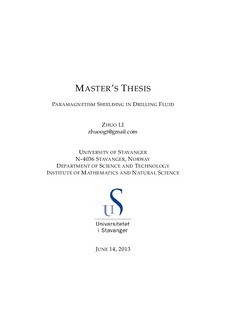Paramagnetism shielding in drilling fluid
Master thesis
Permanent lenke
http://hdl.handle.net/11250/182561Utgivelsesdato
2013Metadata
Vis full innførselSamlinger
Sammendrag
In drilling operations, drilling fluid containing magnetic materials
is used when drilling a well. The materials can significantly shield
the Earth’s magnetic field as measured by magnetic sensors inside
the drilling strings. The magnetic property of the drilling fluid is
one of the substantial error sources for the determination of magnetic
azimuth for wellbores. Both the weight material, cuttings, clay and
other formation material plus metal filings from the tubular wear may
distort the magnetometer readings. This effect is obviously linked to
the amount and kind of magnetic material in the drilling fluid, and
the development of corrective means has therefore highlighted the
drilling fluid.
The influence on directional Measurement While Drilling (MWD)
from drilling fluids has been studied using finite element modeling
techniques. The simulations have been performed for several cases
with realistic representations of MWD tool geometries and varying
location of Bottom Hole Assembly (BHA) versus the wellbore. The
wellbore, tools and magnetic fields were modeled by finite element
methods. The wellbore is modelled as a perfect circular cylinder. With
unsymmetrical geometry the placement of the magnetic MWD sensors
may become more sensitive to magnetic shielding effects, and
small position changes may result in significant errors in the measured
magnetic field components, both attenuation and amplification
[1]. One important result is that for situations with perfect axial symmetry,
the magnetometer readings are attenuated proportionally to
the square of the magnetic susceptibility. Since the magnetic susceptibility
is a small number, this means that the effect on magnetometer
readings is generally negligible. However, if the symmetry is broken,
the distortion on the magnetometer readings can be increased significantly.
This means that segregation of cuttings, metal filings or weight
material can strongly influence the strength of the measured magnetic
fields [1].
It has been shown sometimes to cause significant errors in the accuracy
of drilling hole positioning using magnetic surveying. Here we
present a general physical approach for correcting the measured magnetic
fields from paramagnetism by the paramagnetic material for such
in drilling fluid. Based on information of the paramagnetic properties
of the drilling fluid and the well geometry, applied to a sufficiently
long straight section of a well [2] this paper will show how the magnetic
field in a cylindrical wellbore can be calculated analytically by
using conformal mapping .
Beskrivelse
Master's thesis in Applied science
